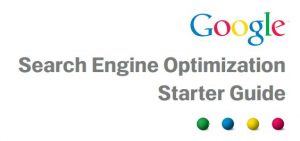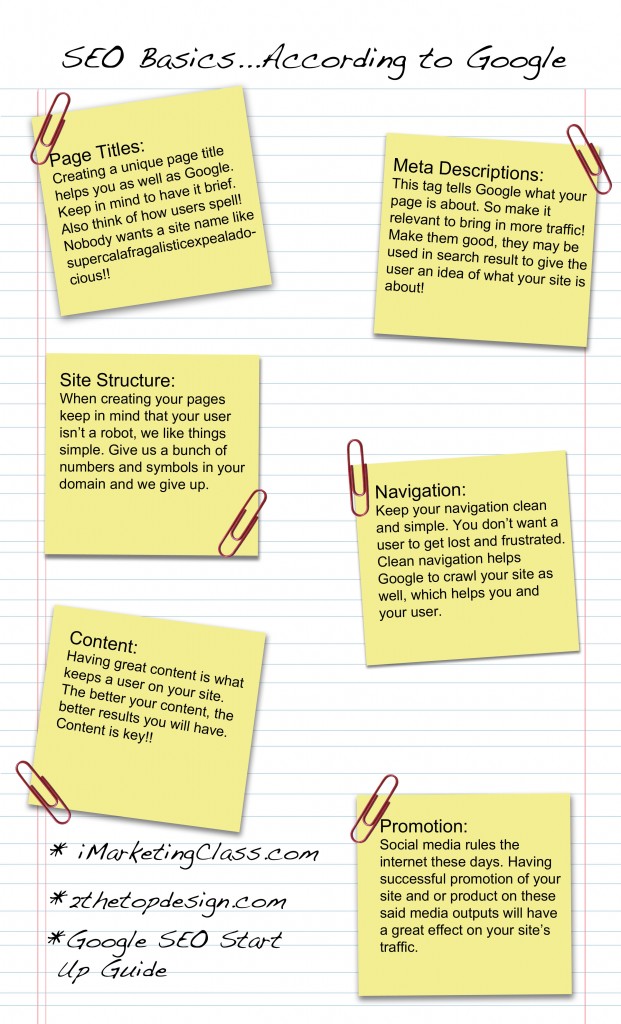 When trying to learn the basics of SEO, short hand terms for Search Engine Optimization, there are some key targets you should know. Knowing just these few attributes can help set your website above all the rest. But first, you should know why search engine optimization is so important to Google, and other various engines, as well as your business. Once you understand why it is so important, the rest comes easily.
When trying to learn the basics of SEO, short hand terms for Search Engine Optimization, there are some key targets you should know. Knowing just these few attributes can help set your website above all the rest. But first, you should know why search engine optimization is so important to Google, and other various engines, as well as your business. Once you understand why it is so important, the rest comes easily.
Google actually helps us alot by providing an official Google SEO starter Guide. The guide is pretty long so I’ve summarized the most important parts in this post.
Why is search engine optimization so important you ask? Well here is just one example. Let’s say that a person in your city is looking for a service that your business provides. Many people like to do their own researching online before calling up companies. In fact, most people get phone numbers from the companies website. How would your business show up in their random Google search? Did you know that Google has methodology that puts websites in an order on a person’s search? By knowing just a few objectives behind SEO, it can help your business website closer to the top of the list on a person’s Google search. And that will not only help you with business, but it will help your targeted user to find the right thing they have been looking for.
Well what are these objectives that keep getting mentioned?? Well here they are: Page Titles, Meta Descriptions, URL Structure, Navigation, Quality Content, Anchor Text, Images (and how to use them), Heading Tags, and Promotion. The list seems long and tedious, however, it is not. And once you have these basics down pat, you will feel like a Search Engine Optimization Guru!
First things first, Page Titles. Page titles tell Google what that page on your site is about, as well as the user. You want to please both, and by pleasing one side of the party you unintentionally please the other. It’s got a trickle down effect, which is beneficial. The page title is what shows up in the search result therefore you want to make it unique to what the content is about. This unique tag will set that page out from the other pages within your site.
Next up is the Meta Description. You’re probably like “What the heck is a META DESCRIPTION?!†Well, it is a description of what that page is about. This applies to each page on your site. By making them each unique to the page, you’re helping Google and your user. This description is like a summary for Google. That being said, you do not want your Meta tag to be too long, or too short. Ideally it’s best to wrap it up with about 70 characters. Why the character restriction you ask? Well it’s not that you can’t make it longer, because you can. It’s just that when Google shows your website in it’s results it may use your Meta description as a snippet of what your site is about. So it will end up cutting off your snippet after so many characters. You have an estimated time of 3 to 4 second to do just that. By making a user read a paragraph or two on what your site is about, you risk the chance of them bypassing your site all together. Keep it short and simple, yet intuitive.
URL structure is up next! By having descriptive names for the files and content on your site you are helping both your user and Google (see how when you help one, you’re helping the other?!).  Your site becomes friendly to the user and to Google. Something to keep in mind when naming your URLs is spelling. You want your URLs to be something easily remembered. By putting fancy symbols and numbers in the URL, you have a high risk of no one being able to find it, or memorize it. Something that can help your site stand out to Google and to your user is having a site map on it. A site map is kind of like a phone book. It shows the structure of your site so that users can easily find something they are looking for. It is typically made in a hierarchical list. Keeping your URLs both simple and organized your present a win/win case to Google and the user.
Navigation is also key! Having a site map on your website can greatly help with this too. The focus of your navigation should always revolve around the functionality of the site. It should all be easy to use, as well as remember. By having a site that is easy to use it becomes memorable to your user. It can be one factor that keeps bringing them back. And it will keep bringing Google back as well.
Content is by far one of the most important factors. You want your content to be both compelling and useful. This is why you get traffic onto your site. Without content that is relative to the subject, there would be no user. You want to get the user’s attention, and keep it. You accomplish this with your content. Make it awesome!
Anchor text is in your content, so it is also important. Anchor text is the text within your content that is clickable. That means, that when it is being read it is typically a different color so that it stands out. This is because when it is clicked, it takes the user to a different page; it’s a link that can be internal (as in it points to one of your other pages) or external (as in it points to another site). Something that is good to know is that your anchor text on your site can say anything you want it to. It does not have to be the other site’s URL. Whatever you make it to be is what Google sees. But the more relative the anchor text is, the more success you will have with both Google and the user. You want it to be descriptive and concise.
Next up is knowing how to use your images. They seem like they are just cut and dry, point blank in your face kind of deal, but they are not. You can optimize them!! And Google loves optimization! But how do you optimize a picture you ask? Easy! Here’s how. Within your code you have an “alt†attribute associated with each image. This alt tag tells both Google what it is of, as well as your user. These alt tags are what screen readers read out to visually impaired users. By accessing them you are helping out your users who may have vision impairment, or maybe they just have their images turned off. And you are also helping Google see your site in the best of light.
Next up are your heading tags. Your heading tags are exactly what they sound like. They are the headers of the pages on your site. You first catch a reader’s eye with them so they are important! They are used to help emphasize the most important text on your page. The absolute best practice is to make them an h1. Meaning the biggest an h tag can go. If you make the heading tag an image, you risk the user not being able to see it, along with Google refusing to read it as a header. It will only read it as an image; with can be harmful for bringing in traffic to your site. Use your heading tags wisely.
Last up is promotion. This is important in almost every field. How is something advertised if it is not promoted? How do people find things out if they aren’t promoted? Well the answer is…they don’t. This is why promotion of your site is so important. When your content is promoted effectively, you will bring in traffic to your site, as well as a faster discovery by Google. How do you promote your site and or your business? Well what rules most of the Internet these days? That’s right, social media! Many people keep up to date by using various social sites. By having your site and content promoted on a blog, or other recognizable sites, you bring in traffic from those sites. And other ways for Google to find you! It’s important to reach out for the social things related to your community if you feel that that is where most of your business will be coming from. By accessing social media, you are gaining so much in return. That is why knowing about it will help you, your business, your site, your potential client, and Google!
So there you go. You already know more SEO than so many others out there. As mentioned, these are only a few starting basics to get you up and running. But by accessing all of these you are only bringing your site higher and higher up on the Google results page. How cool is that?! You are definitely getting closer to reaching your SEO Guru title!

Resources:
The Google SEO Start Up Guide
Ross Jones of 2 The Top Web Design